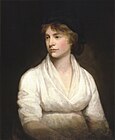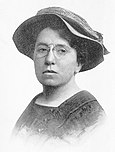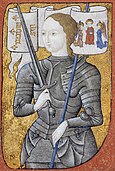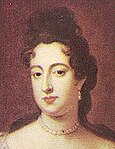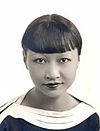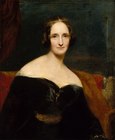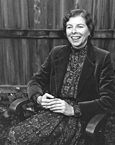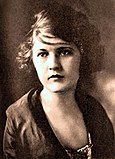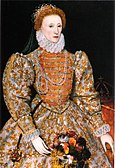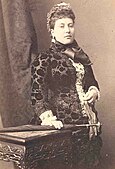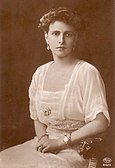Portal:Feminism/Selected biography
Instructions
[edit]The layout design for these subpages is at Portal:Feminism/Selected biography/Layout.
- Add a new Selected article to the next available subpage.
- The list should only contain articles that have been given a quality rating of Wikipedia:Featured articles.
- The "blurb" for all selected articles should be approximately 10 lines, for appropriate formatting in the portal main page.
- Update "max=" to new total for its {{Random portal component}} on the main page.
Selected biographies list
[edit]Portal:Feminism/Selected biography/1
Mary Wollstonecraft was a British writer, philosopher, and early feminist. During her brief career, she wrote novels, treatises, travel narratives, a conduct book, a history of the French Revolution, and a children's book. Wollstonecraft is best known for A Vindication of the Rights of Woman in which she argued that women are not naturally inferior to men, but only appeared to be because they lacked education. She suggested that both men and women should be treated as rational beings and imagined a social order founded on reason. Among both the general public and feminists, Wollstonecraft's life has often received as much, if not more, interest than her writing because of her unconventional, and often tumultuous, relationships. After two unsuccessful affairs with Henry Fuseli and Gilbert Imlay, Wollstonecraft married the philosopher William Godwin, one of the forefathers of the anarchist movement. She was also the mother of Mary Shelley, the author of Frankenstein. Wollstonecraft died at the age of thirty-eight due to complications from childbirth, leaving behind several unfinished manuscripts. Today, Wollstonecraft is considered a foundational thinker in feminist philosophy. Her early advocacy of women's equality and her attacks on conventional femininity and the degradation of women presaged the later emergence of the feminist political movement.
Portal:Feminism/Selected biography/2
Bette Davis was a two-time Academy Award-winning American actress of film, television and theatre. Noted for her willingness to play unsympathetic characters, she was highly regarded for her performances in a range of film genres, from contemporary crime melodramas to historical and period films and occasional comedies, though her greatest successes were romantic dramas. Until the late 1940s, she was one of American cinema's most celebrated leading actresses, known for her forceful and intense style. Her forthright manner, clipped vocal style and ubiquitous cigarette contributed to a public persona which has often been imitated and satirized. Davis was the co-founder of the Hollywood Canteen, and was the first female president of the Academy of Motion Picture Arts and Sciences. Her career went through several periods of decline, and she admitted that her success had often been at the expense of her personal relationships. Married four times, she was once widowed and thrice divorced, and raised her children as a single parent. Her final years were marred by a long period of ill health, however she continued acting until shortly before her death from breast cancer, with more than a hundred film, television and theater roles to her credit. In 1999, Davis was placed second, behind Katharine Hepburn, on the American Film Institute's list of the greatest female stars of all time.
Portal:Feminism/Selected biography/3
Emma Goldman was an anarchist known for her political activism, writing, and speeches. She was lionized as a free-thinking "rebel woman" by admirers, and derided as an advocate of politically-motivated murder and violent revolution by her critics. Born in the province of Kaunas, Lithuania she moved with her sister Helena to Rochester, New York in the United States at the age of sixteen. Attracted to anarchism after the Haymarket Riot, Goldman was trained by Johann Most in public speaking and became a renowned lecturer, attracting crowds of thousands. The writer and anarchist Alexander Berkman became her lover, lifelong intimate friend and comrade. Together they planned to assassinate Henry Clay Frick as an act of propaganda of the deed. Though Frick survived, Berkman was sentenced to twenty-two years in prison. In 1917 Goldman and Berkman were sentenced to two years in jail for conspiring to "induce persons not to register" for the newly instated draft. After their release from prison, they were arrested – with hundreds of others – and deported to Russia. Initially supportive of that country's Bolshevik revolution, Goldman quickly voiced her opposition to the Soviet use of violence and the repression of independent voices. Eventually she traveled to Spain to participate in that nation's civil war. She died in Toronto on 14 May 1940.
Portal:Feminism/Selected biography/4
Catherine de' Medici (1519 - 1589) was born in Florence, Italy, as Caterina Maria Romula di Lorenzo de' Medici. Her parents, Lorenzo II de' Medici, Duke of Urbino, and Madeleine de la Tour d'Auvergne, Countess of Boulogne, both died within weeks of her birth. In 1533, at the age of fourteen, Caterina married Henry, second son of King Francis I of France and Queen Claude. Under the gallicised version of her name, Catherine de Médicis, she was queen consort of King Henry II of France from 1547 to 1559. Throughout Henry II's reign, he excluded Catherine from influence and instead showered favours on his mistress, Diane de Poitiers. Henry's death in 1559 thrust Catherine into the political arena as mother of the frail fifteen-year-old King Francis II. When he too died in 1560, she was appointed regent on behalf of her ten-year-old son King Charles IX and was granted sweeping powers. After Charles died in 1574, Catherine played a key role in the reign of her third son, Henry III. He dispensed with her advice only in the last months of her life. The years in which they reigned have been called "the age of Catherine de' Medici".
Portal:Feminism/Selected biography/5
Barbara McClintock was a pioneering American scientist and one of the world's most distinguished cytogeneticists. McClintock received her PhD in botany from Cornell University in 1927, where she was a leader in the development of maize cytogenetics; the field remained the focus of her research for the rest of her career. Her work was groundbreaking: she developed the technique to visualize maize chromosomes and used microscopic analysis to demonstrate many fundamental genetic concepts, including genetic recombination by crossing-over during meiosis—a mechanism by which chromosomes exchange information. She produced the first genetic map for maize, linking regions of the chromosome with physical traits, and she demonstrated the role of the telomere and centromere, regions of the chromosome that are important in the conservation of genetic information. During the 1940s and 1950s, McClintock discovered transposition and using this system showed how genes are responsible for turning on or off physical characteristics. Awards and recognition of her contributions to the field followed, including the Nobel Prize in Physiology or Medicine awarded to her in 1983 for the discovery of genetic transposition; she was the first and only woman to receive an unshared Nobel Prize in that category.
Portal:Feminism/Selected biography/6
Aspasia was a renowned woman of ancient Greece, famous for her romantic involvement with the Athenian statesman Pericles. She was born in the city of Miletus in Asia Minor, but at some point she travelled to Athens, where she spent the rest of her life. After Pericles' death, she was allegedly involved with Lysicles, another Athenian statesman and general. She had a son with Pericles, Pericles the Younger, who was elected general and was executed after the Battle of Arginusae. Aspasia appears in the philosophical writings of Plato and other philosophers and is regarded by modern scholars as an exceptional person who distinguished herself due to her political influence and intellectual charisma. However, almost nothing is certain about her life. While ancient writers report that Aspasia was a brothel keeper and a harlot, many of these were comic poets who intended to ridicule Pericles and the war rather than document anything factual about Aspasia, and their accounts are disputed. Some researchers question even the assessment that she was a hetaera, or courtesan.
Portal:Feminism/Selected biography/7
Joan of Arc is a national heroine of France and a saint of the Roman Catholic Church. She had visions, believed to be from God, which led to the liberation of her homeland from English dominance in the Hundred Years' War. The then-uncrowned King Charles VII sent her to the siege of Orléans as part of a relief mission. She gained prominence when she overcame the disregard of veteran commanders and ended the siege in only nine days. Several more swift victories led to Charles VII's coronation at Rheims and settled the disputed succession to the throne. The renewed French confidence outlasted Joan of Arc's own brief career. She refused to leave the field when she was wounded during an attempt to recapture Paris that fall. Hampered by court intrigues, she led only minor companies from then on, and fell prisoner during a skirmish near Compiègne the following spring. A politically-motivated trial convicted her of heresy. The English regent, John, Duke of Bedford, had her burnt at the stake in Rouen. Pope Callixtus III reopened Joan's case; a new finding overturned the original conviction. Her piety to the end impressed the retrial court. Pope Benedict XV canonized her on 16 May 1920.
Portal:Feminism/Selected biography/8
Hilda Doolittle, better known by the pen name H.D., was an American poet, novelist and memoirist. She is best known for her association with the key early 20th century avant-garde Imagist group of poets, although her later writing represents a move away from the Imagist model and towards a distinctly feminine version of modernist poetry and prose. Doolittle was one of the leading figures in the bohemian culture of London in the early decades of the century. Her work is noted for its use of classical models and its exploration of the conflict between lesbian and heterosexual attraction and love that closely resembled her own life. Her later poetry also explores traditional epic themes, such as violence and war, from a feminist perspective. H.D. was the first woman to be granted the American Academy of Arts and Letters medal.
Portal:Feminism/Selected biography/9
Rebecca Clarke was an English classical composer and violist best known for her chamber music featuring the viola. She is considered one of the most important British composers in the interwar period between World War I and World War II; she has also been called the most distinguished British female composer of her generation. Though she wrote little, due in part to her ideas about the role of a female composer, her work was recognized for its compositional skill. Most of Clarke's works have yet to be published (or have only recently been published), and her work was largely forgotten after she stopped composing. Scholarship and interest in her work revived when she reached her ninetieth birthday in 1976.
Portal:Feminism/Selected biography/10
Anne became Queen of England, Scotland and Ireland on 8 March 1702. Anne's life was marked by many crises relating to succession to the Crown. Her Roman Catholic father, James II, had been forcefully deposed in 1688; her sister and brother-in-law then became Queen and King as Mary II and William III. The failure of Anne and of her sister to produce a child who could survive into adulthood precipitated a succession crisis, which ultimately produced the Act of Union 1707. When, on 1 May 1707, England and Scotland combined into a single Kingdom, Anne became the first Sovereign of Great Britain. Anne was the last British monarch of the House of Stuart; she was succeeded by a distant cousin, George I, of the House of Hanover. Anne's reign was also marked by the development of the two-party system. Anne personally preferred the Tory Party, but endured the Whigs. Her closest friend, and perhaps her most influential advisor, was Sarah Churchill, Duchess of Marlborough, whose husband, John Churchill, 1st Duke of Marlborough, led the English armies in the War of the Spanish Succession.
Portal:Feminism/Selected biography/11
Mary II reigned as Queen of England and Ireland from 13 February 1689 until her death, and as Queen of Scotland (technically as Mary II of Scotland) from 11 April 1689 until her death. Mary, a Protestant, came to the throne following the Glorious Revolution, which resulted in the deposition of her Roman Catholic father, James II. Mary reigned jointly with her husband and first cousin, William III, who became the sole ruler upon her death. Popular histories usually know the joint reign as that of "William and Mary". Mary, although a sovereign in her own right, did not wield actual power during most of her reign. She did, however, govern the realm when her husband was abroad fighting wars.
Portal:Feminism/Selected biography/12
Sir John Vanbrugh was an English architect and dramatist, best known as the designer of Blenheim Palace. He wrote two argumentative and outspoken Restoration comedies, The Relapse (1696) and The Provoked Wife (1697), which have become enduring stage favourites but originally occasioned much controversy. Vanbrugh was in many senses a radical throughout his life. As a young man and a committed Whig, he was part of the scheme to overthrow James II, put William III on the throne and protect English parliamentary democracy, dangerous undertakings which landed him in the dreaded Bastille of Paris as a political prisoner. In his career as a playwright, he offended many sections of Restoration and 18th-century society, not only by the sexual explicitness of his plays, but by their messages in defence of women's rights in marriage. His architectural work was as bold and daring as his early political activism and his marriage-themed plays, and jarred conservative opinions on the subject.
Portal:Feminism/Selected biography/13
Anna May Wong (1905–1961) was an American actress, the first Chinese-American movie star, and the first Asian-American to become an international star. Her long and varied career spanned film, television, stage, and radio. During the silent film era, her more notable roles were in The Toll of the Sea (1922), one of the first movies made in color; Douglas Fairbanks' The Thief of Bagdad (1924), and Piccadilly (1929). Frustrated by the stereotypical supporting roles she reluctantly played in Hollywood, she left for Europe in the late 1920s, and starred in several notable films and plays. She paid less attention to her film career during the war years, when she devoted her time and money to helping the Chinese cause against Japan. Wong returned to the public eye in the 1950s in several television appearances as well as her own series in 1951, The Gallery of Madame Liu-Tsong, the first U.S. television show starring an Asian-American. She had been planning to return to film in Flower Drum Song when she died in 1961, at the age of 56. Her life and career were re-evaluated in the years around the centennial of her birth, in three major literary works and film retrospectives.
Portal:Feminism/Selected biography/14
Diane Keaton is an American film producer, director, and actor. Keaton began her career as a stage actor, and made her screen debut in 1970. Keaton's first major film role was as Kay Adams in The Godfather (1972), but the films that shaped her early career were those with director and co-star Woody Allen. Her films with Allen such as Sleeper (1973), Love and Death (1975), and her Academy Award-winning performance in Annie Hall established her as a comic actor. Keaton has claimed that she is "tailor-made for comedy". Keaton ceased collaborating with Allen in 1979, and took on new roles to avoid becoming typecast as her Annie Hall persona. She became an accomplished dramatic actor, starting with Looking for Mr. Goodbar (1977) and received Academy Award nominations for Reds (1981) and Marvin's Room (1996). Some of her popular recent films include Father of the Bride (1991), The First Wives Club (1996), and Something's Gotta Give (2003). Keaton's films have earned a cumulative gross of over $1.1 billion USD in North America.
Portal:Feminism/Selected biography/15
Princess Louise, Duchess of Argyll was a member of the British Royal Family, the fourth daughter and sixth child of Queen Victoria and Prince Albert. Louise spent her early life under the roof of her parents, and when her father died in 1861, she took on the role as a companion to her mother. In 1871, Louise married John Campbell, Marquess of Lorne, and became the first daughter of a sovereign to marry a British subject since 1515. Although the marriage was initially happy, the couple drifted apart as a result of their childlessness and the Queen's constraints on their activities. In 1878, Louise's husband was appointed Governor General of Canada, and Louise spent five years as his consort. When Louise returned to Britain, she remained close to the Queen and undertook a number of public duties on her behalf. Following the Queen's death in 1901, she remained close to younger generations of the British royal family, and died in 1939 at the age of 91. Louise was a talented sculptor and an artist, and several of her sculptures remain today.
Portal:Feminism/Selected biography/16
Elizabeth Bowes-Lyon was the Queen Consort of George VI from 1936 until his death in 1952. After her husband's death, she was known as Queen Elizabeth The Queen Mother, to avoid confusion with her elder daughter, Elizabeth II. In 1936, she unexpectedly became Queen when her brother-in-law, Edward VIII, suddenly abdicated in order to marry his mistress, the twice-divorced American Wallis Simpson. During World War II, her seemingly indomitable spirit provided moral support to the British public, so much so that, in recognition of her role as a propaganda tool, Adolf Hitler described her as "the most dangerous woman in Europe." After the war, her husband's health deteriorated and she was widowed at the age of 51. With her brother-in-law living abroad and her elder daughter now Queen at the age of 26, when Queen Mary died in 1953, Elizabeth became the senior royal and assumed a position as family matriarch. In her later years, she was a consistently popular member of the British Royal Family, when other members were suffering from low levels of public approval. Only after the illness and death of her own younger daughter, Princess Margaret, did she appear to grow frail. She died six weeks after Margaret, at the age of 101.
Portal:Feminism/Selected biography/17
Hannah Primrose, Countess of Rosebery was the daughter of Baron Mayer de Rothschild and his wife Juliana, née Cohen. On the death of her father in 1874 she became the richest woman in Britain. Her husband, the 5th Earl of Rosebery, was, during the final quarter of the nineteenth century, one of the most celebrated figures in Britain, an influential millionaire and politician, whose charm, wit, charisma and public popularity gave him such standing that he "almost eclipsed royalty". Her marriage into the aristocracy, while controversial at the time, gave her the social cachet in an anti-Semitic society that her vast fortune could not. She subsequently became a political hostess and philanthropist. Her charitable work was principally in the sphere of public health and causes associated with the welfare of working class Jewish women living in the poorer districts of London. Having firmly assisted and supported her husband on his path to political greatness, she suddenly died in 1890, aged 39, leaving him to achieve, bewildered and without her support, the political destiny which she had plotted alone. His premiership of the United Kingdom was shambolic, and lasted barely a year.
Portal:Feminism/Selected biography/18
Rosa Parks was an African American civil rights activist and seamstress whom the United States Congress dubbed the "Mother of the Modern-Day Civil Rights Movement". Parks is famous for her refusal in 1955 to obey a bus driver's demand that she give up her bus seat to a white passenger. Her subsequent arrest and trial for this act of civil disobedience ignited the Montgomery bus boycott, one of the largest and most successful mass movements against racial segregation in history, and launched Martin Luther King Jr., one of the organizers of the boycott, to the forefront of the civil rights movement. Her role in American history earned her an iconic status in American culture, and her actions have left an enduring legacy for worldwide civil rights movements.
Portal:Feminism/Selected biography/19
Rachel Carson was an American marine biologist and nature writer whose writings are often credited with launching the global environmental movement. Carson started her career as a biologist in the U.S. Bureau of Fisheries, and transitioned to a full-time nature writer in the 1950s. Her widely praised 1951 bestseller The Sea Around Us won her financial security and recognition as a gifted writer. Her next book, The Edge of the Sea, and the republished version of her first book, Under the Sea-Wind, were also bestsellers. Together, her sea trilogy explores the gamut of ocean life, from the shores to the surface to the deep sea. In the late 1950s, Carson turned her attention to conservation and the environmental problems caused by synthetic pesticides. The result was Silent Spring (1962), which brought environmental concerns to an unprecedented portion of the American public. Silent Spring spurred a reversal in national pesticide policy—leading to a nationwide ban on DDT and other pesticides—and the grassroots environmental movement it inspired led to the creation of the Environmental Protection Agency. Carson was posthumously awarded the Presidential Medal of Freedom.
Portal:Feminism/Selected biography/20
Sharon Tate was an American actress. During the 1960s she played small roles in television, before starting her film career. After receiving positive reviews as a light comedienne, she was hailed as one of Hollywood's promising newcomers. Tate's celebrity status and role as a style icon of the "Swinging Sixties" increased after fashion magazines began featuring her as a model and cover girl. Married to the film director Roman Polański, Tate was eight months pregnant when she, along with four others, was murdered in her Benedict Canyon home by followers of Charles Manson, in a crime that shocked the nation. A decade after the murders, her mother Doris Tate, appalled at the growing cult status of the killers and the possibility that any of them might be granted parole, joined a campaign to ensure they remained in prison. This was part of the catalyst which led to amendments to California law in 1982, which allowed crime victims and their families to make victim impact statements.
Portal:Feminism/Selected biography/21
Marjory Stoneman Douglas (1890 - 1998) was an American journalist, writer and environmentalist known for her staunch defense of the Florida Everglades against draining and development. Moving to Miami as a young woman to work for The Miami Herald, Douglas became a freelance writer, producing over a hundred short stories that were published in popular magazines. Her most influential work was the book The Everglades: River of Grass (1947), which redefined the popular conception of the Everglades as a treasured river instead of a worthless swamp; its impact has been compared to that of the influential 1962 book Silent Spring. Her books, stories, and journalism career brought her influence in Miami, which she used to advance her causes. Even as a young woman Douglas was outspoken and politically conscious of many issues that included women's suffrage and civil rights. She was called upon to take a central role in the protection of the Everglades when she was 79 years old. Numerous awards were given to her, including the Presidential Medal of Freedom, and she was inducted into several halls of fame. Douglas lived until age 108, working until nearly the end of her life for Everglades restoration.
Portal:Feminism/Selected biography/22
Mary Shelley (née Mary Wollstonecraft Godwin; 30 August 1797 – 1 February 1851) was a British novelist, short story writer, dramatist, essayist, biographer, and travel writer, best known for her Gothic novel Frankenstein: or, The Modern Prometheus (1818). She also edited and promoted the works of her husband, the Romantic poet and philosopher Percy Bysshe Shelley. Her father was the political philosopher William Godwin, and her mother was the philosopher and feminist Mary Wollstonecraft. Until the 1970s, Mary Shelley was known mainly for her efforts to publish Percy Shelley's works and for her novel Frankenstein, which remains widely read and has inspired many theatrical and film adaptations. Recent scholarship has yielded a more comprehensive view of Mary Shelley’s achievements. Scholars have shown increasing interest in her literary output, particularly in her novels, which include the historical novels Valperga (1823) and Perkin Warbeck (1830), the apocalyptic novel The Last Man (1826), and her final two novels, Lodore (1835) and Falkner (1837). Studies of her lesser-known works such as the travel book Rambles in Germany and Italy (1844) and the biographical articles for Dionysius Lardner's Cabinet Cyclopaedia (1829–46) support the growing view that Mary Shelley remained a political radical throughout her life. Mary Shelley's works often argue that cooperation and sympathy, particularly as practised by women in the family, were the ways to reform civil society. This view was a direct challenge to the individualistic Romantic ethos promoted by Percy Shelley and the Enlightenment political theories articulated by her father, William Godwin.
Portal:Feminism/Selected biography/23
Sarah Trimmer (née Kirby) (1741 – 1810) was a noted writer and critic of British children's literature in the eighteenth century. Her periodical, The Guardian of Education, helped to define the emerging genre by seriously reviewing children's literature for the first time. Trimmer's most popular children's book, Fabulous Histories, inspired numerous children's animal stories and remained in print for over a century. Trimmer was an active philanthropist as well as author; she founded several Sunday schools and charity schools in her parish. To further these educational projects, she not only wrote textbooks but she also penned manuals for other women interested in starting their own schools. Trimmer's efforts inspired other women, such as Hannah More, to establish Sunday school programs and to write for children and the poor. Trimmer was in many ways dedicated to maintaining the social and political status quo in her works. As a high church Anglican, she was intent on promoting the Established Church of Britain and on teaching young children and the poor the doctrines of Christianity. Her writings outlined the benefits of social hierarchies, arguing that each class should remain in its God-given position. Yet, while supporting many of the traditional political and social ideologies of her time, Trimmer questioned others, such as those surrounding gender and the family.
Portal:Feminism/Selected biography/24
Harriet Tubman (born Araminta Ross; c.1820 – 10 March 1913) was an African-American abolitionist, humanitarian, and Union spy during the U.S. Civil War. After escaping from captivity, she made thirteen missions to rescue over seventy slaves using the network of antislavery activists and safe houses known as the Underground Railroad. She later helped John Brown recruit men for his raid on Harpers Ferry, and in the post-war era struggled for women's suffrage. Born into slavery in Dorchester County, Maryland, Tubman was beaten and whipped by her various owners as a child. In 1849, Tubman escaped to Philadelphia, then immediately returned to Maryland to rescue her family. Slowly, one group at a time, she brought relatives with her out of the state, and eventually guided dozens of other slaves to freedom. When a far-reaching United States Fugitive Slave Law was passed in 1850, she helped guide fugitives further north into Canada, and helped newly-freed slaves find work. When the American Civil War began, Tubman worked for the Union Army, first as a cook and nurse, and then as an armed scout and spy. The first woman to lead an armed expedition in the war, she guided the raid on the Combahee River, which liberated more than seven hundred slaves. She was active in the women's suffrage movement until illness overtook her and she had to be admitted to a home for elderly African-Americans she had helped open years earlier. After she died in 1913, she became an icon of American courage and freedom.
Portal:Feminism/Selected biography/25
Ann Bannon (pseudonym of Ann Weldy) (1932 - ) is an American writer who wrote six lesbian pulp fiction novels from 1957 to 1962 known as The Beebo Brinker Chronicles. The books' enduring popularity and impact on lesbian identity has earned her the title "Queen of Lesbian Pulp Fiction". Bannon was a young housewife trying to address her own issues of sexuality when she was inspired to write her first novel, which became the second best-selling paperback of 1957. Despite her traditional upbringing and role in married life, her novels defied conventions for romance stories and depictions of lesbians, by addressing complex homosexual relationships positively during the morally repressive era of the 1950s and 1960s. Although her books shaped lesbian identity for lesbians and heterosexuals alike, Bannon was unaware of their impact. She stopped writing in 1962 and later earned a doctorate in linguistics and became an academic. She endured a difficult marriage for 27 years and as she separated from her husband in the 1980s, her books were republished and she was stunned to learn of their influence on society. They were released again in 2001, and have been adapted as an award-winning Off-Broadway production. They are taught in Women's and LGBT studies courses, and Bannon has been given numerous awards for pioneering lesbian and gay literature.
Portal:Feminism/Selected biography/26
Anna Laetitia Barbauld (née Aikin) (1743 - 1825) was a prominent eighteenth-century English poet, essayist, and children's author. A "woman of letters" who published in multiple genres, Barbauld had a successful writing career at a time when female professional writers were rare. She was a noted teacher at the celebrated Palgrave Academy and an innovative children's writer; her famous primers provided a model for pedagogy for more than a century. Her essays demonstrated that it was possible for a woman to be publicly engaged in politics, and other women authors emulated her. Even more importantly, her poetry was foundational to the development of Romanticism in England. Barbauld was also a literary critic, and her anthology of eighteenth-century British novels helped establish the canon as we know it today. Barbauld's literary career ended abruptly in 1812 with the publication of her poem Eighteen Hundred and Eleven, which criticized Britain's participation in the Napoleonic Wars. The vicious reviews shocked Barbauld and she published nothing else within her lifetime. The rise of feminist literary criticism in the 1980s renewed interest in her works and restored her place in literary history.
Portal:Feminism/Selected biography/27
Natalie Clifford Barney (1876 - 1972) was an American expatriate who lived, wrote and hosted a literary salon in Paris. She was a noted poet, memoirist and epigrammatist. Barney's salon was held at her home on Paris's Left Bank for more than 60 years and brought together writers and artists from around the world, including many leading figures in French literature along with American and British Modernists of the Lost Generation. She worked to promote writing by women and formed a "Women's Academy" in response to the all-male French Academy while also giving support and inspiration to male writers from Remy de Gourmont to Truman Capote. She was openly lesbian and began publishing love poems to women under her own name as early as 1900, considering scandal as "the best way of getting rid of nuisances". In her writings she supported feminism, paganism and pacifism. She opposed monogamy and had many overlapping, long and short-term relationships, including an on-and-off romance with poet Renée Vivien and a 50-year relationship with painter Romaine Brooks. Her life and love affairs served as inspiration for many novels, ranging from the salacious French bestseller Sapphic Idyll to The Well of Loneliness, arguably the most famous lesbian novel of the 20th century.
Portal:Feminism/Selected biography/28
Zelda Sayre Fitzgerald (1900 - 1948), born Zelda Sayre in Montgomery, Alabama, was a novelist and the wife of writer F. Scott Fitzgerald. She was an icon of the 1920s—dubbed by her husband "the first American Flapper". After the success of his first novel This Side of Paradise, the Fitzgeralds became celebrities. The newspapers of New York saw them as embodiments of the Jazz Age and the Roaring Twenties: young, rich, beautiful, and energetic. She met F. Scott Fitzgerald at a dance, and despite fights and a prolonged break-up, they married in 1920 and spent the early part of the decade as literary celebrities in New York. The strain of her tempestuous marriage, Scott's increasing alcoholism, and her growing instability presaged Zelda's admittance to a sanatorium in 1930. She was diagnosed with schizophrenia. While in a Maryland clinic, she wrote a semi-autobiographical novel, Save Me the Waltz, which was published in 1932. Back in America, Scott went to Hollywood where he tried screenwriting and began an affair with the movie columnist Sheilah Graham. In 1936, Zelda entered the Highland Mental Hospital in Asheville, North Carolina. In 1948, the hospital at which she had been a patient caught fire, causing her death. After a life as an emblem of the Jazz Age, Roaring Twenties, and Lost Generation, Zelda Fitzgerald posthumously found a new role: after a popular 1970 biography portrayed her as a victim of an overbearing husband, she became a feminist icon.
Portal:Feminism/Selected biography/29
Amalie Emmy Noether, (1882 - 1935) was a German Jewish mathematician who is known for her seminal contributions to abstract algebra. Often described as the most important woman in the history of mathematics, she revolutionized the theories of rings, fields, and algebras. She is also known for her contributions to modern theoretical physics, especially for the first Noether's theorem which explains the connection between symmetry and conservation laws. Born in the Bavarian town of Erlangen to the noted mathematician Max Noether, Emmy originally planned to teach French and English after passing the required examinations. She did not pursue languages, however, and studied mathematics at the University of Erlangen, where her father lectured. After completing her dissertation in 1907 under the supervision of Paul Gordan, she worked at the Mathematical Institute of Erlangen without pay for seven years. In 1915, she was invited by David Hilbert and Felix Klein to join the mathematics department at the University of Göttingen. The Philosophical faculty objected, however, and she spent four years lecturing under Hilbert's name. Her Habilitation process was approved in 1919, paving the way for her to obtain the rank of Privatdozent. By the time she delivered a major address at the 1932 International Congress of Mathematicians in Zürich, her algebraic acumen was recognized around the world. She remained at Göttingen until 1933 when she was fired by Germany's Nazi government, and she moved to the United States, where she took a position at Bryn Mawr College in Pennsylvania. In 1935, she underwent surgery for an ovarian cyst and, despite signs of speedy recovery, died four days later at the age of 53.
Portal:Feminism/Selected biography/30
Anne of Denmark (1574 - 1619) was queen consort of James VI of Scots, I of England and Ireland. The second daughter of King Frederick II of Denmark, Anne married James in 1589 at the age of fourteen and bore him three children who survived infancy, including the future Charles I. She demonstrated an independent streak and a willingness to use factional Scottish politics in her conflicts with James over the custody of Prince Henry and his treatment of her friend Beatrix Ruthven. Anne appears to have loved James at first, but the couple gradually drifted and eventually lived apart, though mutual respect and a degree of affection survived. In England, Anne shifted her energies from factional politics to patronage of the arts and constructed a magnificent court of her own, hosting one of the richest cultural salons in Europe. After 1612, she suffered sustained bouts of ill health and gradually withdrew from the centre of court life. Though she was reported to have died a Protestant, evidence suggests that she may have converted to Catholicism at some stage in her life. Historians have traditionally dismissed Anne as a lightweight queen, frivolous and self-indulgent. However, recent reappraisals acknowledge Anne's assertive independence and, in particular, her dynamic significance as a patron of the arts during the famous Jacobean age.
Portal:Feminism/Selected biography/31
Sarah Churchill (née Jenyns), Duchess of Marlborough (1660 - 1774) rose to be one of the most influential women in British history, as a result of her close friendship with Queen Anne of Great Britain. Sarah's friendship and influence with Princess Anne was widely known, and leading public figures often turned their attentions to her in the hope that she would influence Anne to comply with requests. As a result, by the time Anne became queen, Sarah’s knowledge of government, and intimacy with the Queen, allowed her to become a powerful friend and a dangerous enemy, the last in the long line of Stuart favourites. In an age when marriage was principally for money, not love, Sarah enjoyed an unusually close relationship with her husband, John Churchill, the first Duke of Marlborough, whom she married in 1677. Sarah acted as Anne's agent after James II, Anne's father, was deposed during the Glorious Revolution; and she promoted her interests during the rule of James's successors, William III and Mary II. When Princess Anne came to the throne after William's death in 1702, the Duke of Marlborough, together with Sidney Godolphin, the first Earl of Godolphin, rose to head the government, partly as a result of Sarah's friendship with Anne. A patron of the Whig party, Sarah tirelessly campaigned on behalf of the Whigs, while also devoting much of her time to building projects such as Blenheim Palace. She died in 1744 at the age of eighty-four.
Portal:Feminism/Selected biography/32
Elizabeth I (1533 - 1603) was Queen of England and Queen of Ireland from 17 November 1558 until her death. Sometimes called The Virgin Queen, Gloriana or Good Queen Bess, Elizabeth was the fifth (or sixth if Lady Jane Grey is included) and last monarch of the Tudor dynasty. The daughter of Henry VIII, she was born a princess, but her mother, Anne Boleyn, was executed three years after her birth, and Elizabeth was declared illegitimate. Along with her sister, Mary I, she was cut out of the succession by her teenage brother, Edward VI, in order to make way for the daughter-in-law of Edward's overbearing Protector and Regent, John Dudley, 1st Duke of Northumberland. His will, however, was set aside, as it contravened the Third Succession Act of 1543, in which Elizabeth was named as successor provided that Mary I of England, Elizabeth's half-sister, should die without issue. In 1558, Elizabeth succeeded Mary, during whose reign she had been imprisoned for nearly a year on suspicion of supporting Protestant rebels. After the short reigns of Elizabeth's brother and sister, her forty-five years on the throne provided stability for the kingdom and helped forge a sense of national identity.
Portal:Feminism/Selected biography/33
The Princess Helena (Helena Augusta Victoria: Princess Christian of Schleswig-Holstein by marriage; 1846 - 1923) was a member of the British Royal Family, the third daughter and fifth child of Queen Victoria and Prince Albert of Saxe-Coburg and Gotha. Helena was educated by private tutors chosen by her father and his close friend and adviser, Baron Stockmar. The intimate atmosphere of the royal court came to an end on 14 December 1861, when her father died and her mother entered a period of intense mourning. On 5 July 1866, Helena married the impoverished German Prince Christian of Schleswig-Holstein. The couple remained in England, in calling distance of the Queen, who liked to have her daughters nearby, and Helena along with her youngest sister, Princess Beatrice, became the Queen's unofficial secretary. However, after Queen Victoria's death on 22 January 1901, Helena saw relatively little of her surviving siblings. Helena was one of the founding members of the Red Cross. She was founding president of the Royal School of Needlework, and president of the Royal British Nurses' Association. As president of the latter, she was a strong supporter of nurse registration against the advice of Florence Nightingale. She became the first member of her family to celebrate her 50th wedding anniversary in 1916, but her husband died a year later. Helena outlived him by six years, and died aged 77 at Schomberg House on 19 June 1923.
Portal:Feminism/Selected biography/34
Joseph Johnson (1738 - 1809) was an influential eighteenth-century London bookseller. His publications covered a wide variety of genres and a broad spectrum of opinions on important issues. Johnson is best known for publishing the works of radical thinkers such as Mary Wollstonecraft, William Godwin, and Joel Barlow as well as religious Dissenters such as Joseph Priestley, Anna Laetitia Barbauld, and Gilbert Wakefield.In the 1760s, Johnson established his publishing business, which focused primarily on religious works. He also became friends with Priestley and the artist Henry Fuseli—two relationships that lasted his entire life and brought him much business. In the 1770s and 1780s, Johnson expanded his business, publishing important works in medicine and children's literature as well as the popular poetry of William Cowper and Erasmus Darwin. Throughout his career, Johnson helped shape the thought of his era not only through his publications, but also through his support of innovative writers and thinkers. He fostered the open discussion of new ideas, particularly at his famous weekly dinners, the regular attendees of which became known as the "Johnson Circle".
Portal:Feminism/Selected biography/35
Princess Alice of Battenberg, later Princess Andrew of Greece and Denmark (Victoria Alice Elizabeth Julia Marie; 1885 - 1969) was the mother of Prince Philip, Duke of Edinburgh (consort of Queen Elizabeth II). Congenitally deaf, she grew up in Germany, England and the Mediterranean. After marrying Prince Andrew of Greece and Denmark in 1903, she lived in Greece until the exile of most of the Greek Royal Family in 1917. On returning to Greece a few years later, her husband was blamed in part for the defeat of Greece in the Greco–Turkish War of 1919–1922, and the family were once again forced into exile until the restoration of the Greek monarchy in 1935. In 1930, she was diagnosed with schizophrenia and committed to a sanatorium; thereafter, she lived separately from her husband. After her recovery, she devoted most of her remaining years to charity work in Greece. She stayed in Athens during the Second World War, sheltering Jewish refugees, for which she is recognised as "Righteous Among the Nations" at Yad Vashem. After the war, she stayed in Greece and founded an Orthodox nursing order of nuns known as the Christian Sisterhood of Martha and Mary. After the fall of King Constantine II of Greece and the imposition of military rule in Greece in 1967, she was invited by her son and daughter-in-law to live at Buckingham Palace in London, where she died two years later.
Portal:Feminism/Selected biography/36
Stamata Revithi was a Greek woman who ran the 40-kilometre marathon during the 1896 Summer Olympics. The Games excluded women from competition, but Revithi insisted that she be allowed to run. Revithi ran one day after the men had completed the official race, and although she finished the marathon in approximately 5 hours and 30 minutes and found witnesses to sign their names and verify the running time, she was not allowed to enter the Panathinaiko Stadium at the end of the race. She intended to present her documentation to the Hellenic Olympic Committee in the hopes that they would recognize her achievement, but it is not known whether or not she did so. No known record survives of Revithi's life after her run. According to contemporary sources, a second woman, "Melpomene", also ran the 1896 marathon race. There is debate among Olympic historians as to whether or not Revithi and Melpomene are the same person.
Portal:Feminism/Selected biography/37
Emmeline Pankhurst was a political activist and leader of the British suffragette movement. Although she was widely criticised for her militant tactics, her work is recognised as a crucial element in achieving women's suffrage in Britain. However, historians disagree about whether she did more to help or hinder public support for the cause. Born and raised in Manchester by politically active parents, Pankhurst was introduced at a young age to the women's suffrage movement. In 1878 she married Richard Pankhurst, a barrister known for supporting women's right to vote. She quickly became involved with the Women's Franchise League, which advocated suffrage for women. After her husband died in 1898, Pankhurst founded the Women's Social and Political Union, an all-women suffrage advocacy organisation dedicated to "deeds, not words". The group placed itself separately from – and often in opposition to –political parties. The group quickly became infamous when its members smashed windows and assaulted police officers. Pankhurst, her daughters, and other WSPU activists were sentenced to repeated prison sentences, where they staged hunger strikes to secure better conditions. In 1913 several prominent individuals left the WSPU, among them Pankhurst's daughters Adela and Sylvia. The family rift was never healed. With the advent of World War I, Emmeline and her daughter Christabel called an immediate halt to militant suffrage activism in order to support the British government against the "German Peril". They urged women to aid industrial production, and encouraged young men to fight. In 1918 the Representation of the People Act granted votes to women over the age of 30. Pankhurst transformed the WSPU machinery into the Women's Party, which was dedicated to promoting women's equality in public life. In her later years she became concerned with what she perceived as the menace posed by Bolshevism, and – unhappy with the political alternatives – joined the Conservative Party. She died in 1928 and was commemorated two years later with a statue in Victoria Tower Gardens.
Portal:Feminism/Selected biography/38
Margaret Fuller was a journalist, critic and women's rights activist associated with the American transcendental movement. She was the first full-time female book reviewer in journalism. Her book Woman in the Nineteenth Century is considered the first major feminist work in the United States. Born Sarah Margaret Fuller in an area of Cambridge, Massachusetts, she was given a substantial early education by her father, Timothy Fuller. She later had more formal schooling and became a teacher before, in 1839, she began overseeing what she called "conversations": discussions among women meant to compensate for their lack of access to higher education. She became the first editor of the transcendental publication The Dial in 1840 before joining the staff of the New York Tribune under Horace Greeley in 1844. By the time she was in her 30s, Fuller had earned a reputation as the best-read person in New England, male or female, and became the first woman allowed to use the library at Harvard College. Her seminal work, Woman in the Nineteenth Century, was published in 1845. A year later, she was sent to Europe for the Tribune as its first female correspondent. Fuller was an advocate of women's rights and, in particular, women's education and the right to employment. She also encouraged many other reforms in society, including prison reform and the emancipation of slaves in the United States. Many other advocates for women's rights and feminism, including Susan B. Anthony, cite Fuller as a source of inspiration. Shortly after Fuller's death her importance faded; the editors who prepared her letters to be published, believing her fame would be short-lived, were not concerned about accuracy and censored or altered much of her words before publication.
Nominations
[edit]- Adding articles
- Feel free to add Featured quality Feminism-related articles to the above list.
- If you are unsure or do not know how to add an entry, feel free to post a question, suggestion or nomination here below, or at the talk page Portal talk:Feminism.

